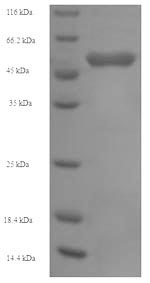CUSABIO team inserts the gene coding for the Human OXCT1 protein (40-520aa) into a plasmid vector to form recombinant plasmid, which is then introduced into e.coli cells. e.coli cells demonstrating successful uptake of the recombinant plasmid are selected based on their ability to survive in the presence of a specific antibiotic. The positive e.coli cells are cultured under conditions that promote the expression of the gene of interest. A N-terminal 6xHis tag is linked to the protein. Following expression, affinity purification is used to isolate and purify the recombinant Human OXCT1 protein from the cell lysate. Denaturing SDS-PAGE is then applied to resolve the resulting recombinant Human OXCT1 protein, demonstrating a purity greater than 90%.






